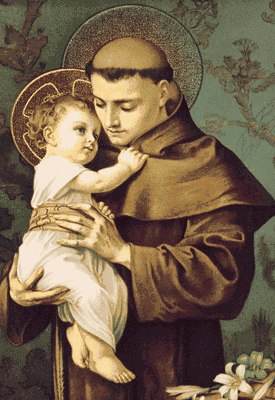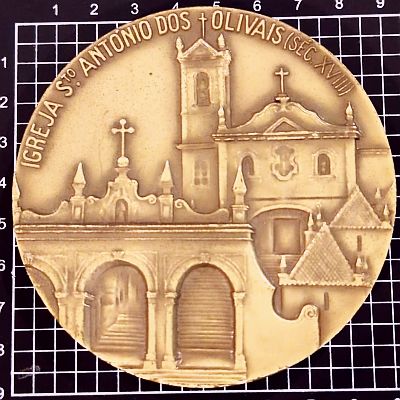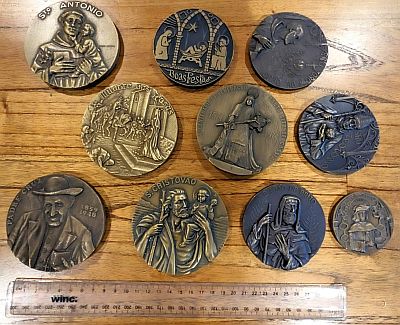A very large medal I hopefully won’t lose

(Painting of St Anthony, from Catholic.org)
St Anthony of Padua
St. Anthony of Padua is one of the Catholic Church’s most popular saints. Saint Anthony of Padua, patron saint of lost and stolen articles, was a powerful Franciscan preacher and teacher. He’s typically portrayed holding the child Jesus—or a lily—or a book—or all three—in his arms.
Anthony was born into a wealthy family in 1195 (13 years after St. Francis) in Lisbon, Portugal. He was given the name of Fernando at Baptism. At the age of fifteen asked to be sent to the Abbey of Santa Cruz in Coimbra, the then capital of the Kingdom of Portugal.
In Anthony’s time, Coimbra was the seat of government of a country that had just freed itself from Muslim rule, and it remained the residence of the royal family until 1260.
During his time in the Abbey, he learned theology and Latin. When Franciscan friars settled a small hermitage outside Coimbra dedicated to Saint Anthony of Egypt, Fernando felt a longing to join them. Fernando eventually received permission to leave the Abbey so he could join the new Franciscan Order. When he was admitted, he changed his name to Anthony.
News of Anthony’s eloquence reached Francis of Assisi, and the two became friends.
In 1224, Francis entrusted his friars’ pursuits of studies to Anthony. Anthony had a book of psalms that contained notes and comments to help when teaching students and, in a time when a printing press was not yet invented, he greatly valued it.
When a novice decided to leave the hermitage, he stole Anthony’s valuable book. When Anthony discovered it was missing, he prayed it would be found or returned to him. The thief did return the book and in an extra step returned to the Order as well.
So simple and resounding was his teaching of the Catholic Faith, most unlettered and the innocent could understand his messages. It is for this reason he was declared a Doctor of the Church by Pope Pius XII in 1946. He was only 35 years old when he died and was canonized less than one year afterward by Pope Gregory IX in 1232.
Saint Anthony’s feast day is June 13
Obverse

The obverse features a very recognisable portrait of Saint Anthony, with the inscription in Portuguese reading his name “Sto. Antonio” (Saint Anthony).
Saint Anthony is depicted holding the infant Jesus, a book (a bible?), and a lily.
The maker’s name is also written to the right: “Cabral Antunes” (1916-1986). Cabral was a sculptor from Coimbra, Portugal, with particular emphasis on medals, with numerous medals and statues.
Reverse

The text reads “IGREJA SANTO ANTONIO DOS OLIVAIS SEC XVIII”. This translates to “Church of Saint Antonio dos Olivais 18th century”.
In 1217-8, Queen Urraca (wife of Afonso II) donated a small chapel on a hill of olive groves to the first Franciscan friars arriving in Portugal, which they transformed into a humble hermitage dedicated to Saint Anthony the Great, changing its patron to Saint Anthony of Padua after Anthony’s death.
In 1851, a fire gutted the cloister, dormitory and other dependencies of the convent. The church was rebuilt and still stands today.

(The ornate Church of Santo António dos Olivais, part of the former monastery of Celas. Image: Wikipedia)
This medal is huge. 90mm diameter, and weighs 284 grams. I picked it up along with a group of other religious medals:

Young Miss Note misplaced a special piece of jewellery she was given yesterday. Very fortunately, it turned up today, and we are very grateful to St Anthony, so this piece definitely speaks to me today. Do any of the others speak to you? Let me know what else you’d like a write up on out of this group! Do you have a favourite medal? Be sure to share on social media and tag us!


Leave a Reply